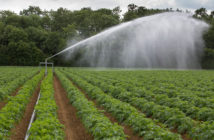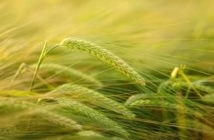An increase in the area planted to spring barley but smaller wheat and oilseed rape areas are among the key findings from AHDB’s 2017 Planting and Variety Survey. Spring barley continues to benefit from a surge in interest in spring cropping, as part of efforts to tackle agronomic challenges, including the control of black-grass, plus as a replacement for previously lost oilseed rape crops.
The key findings of the survey are:
- GB wheat area is estimated at 1.76Mha, a 3 per cent decrease from 2016
- GB spring barley area is estimated at 725,000ha, up 9 per cent from 2016
- GB winter barley area is estimated at 428,000ha, 1 per cent lower than 2016
- Area of oilseed rape in England and Scotland is estimated at 553,000ha, down 4 per cent from 2016
- Area of oats in England and Scotland is estimated at 151,000ha, a 14 per cent increase from 2016
Helen Plant, AHDB senior analyst, said: “In addition to the agronomic challenges, the profitability of many winter crops was also poor when planting decisions were being made. Much of the rise in grain and oilseed prices seen last autumn occurred after planting was underway, giving less opportunity for growers to respond.”
Wheat
At 1.76Mha, the GB wheat area is estimated 3 per cent lower than in 2016. The largest reductions were reported in the eastern regions of England, where black-grass remains a key challenge. Additionally, when many growers were making their planting decisions for harvest 2017, UK wheat prices were still historically low, pressured by high global and UK wheat stocks. Prices in eastern England and Scotland were particularly pressured by local supply and demand factors.
With smaller stocks expected to be carried over from 2016/17 and a smaller GB wheat area, yields will need to exceed 2016 levels for UK supplies to increase in 2017/18. AHDB will be looking at this in more detail and producing production scenarios later this summer. These will be published on the AHDB website.
In terms of varieties, nabim Group 1 and 2 varieties are estimated to account for 40 per cent of the GB wheat area, up from 31 per cent in 2016. This is the highest proportion reported since the inaugural variety survey in 2006 (43 per cent). Interest in Group 1 and 2 varieties has witnessed a resurgence in recent years since the introduction of higher-yielding varieties, which offer greater marketing flexibility to growers.
Despite the recent introduction of higher-yielding Group 3 varieties, this survey did not pick up an increase across all GB regions. nabim Group 3 varieties accounted for five per cent of the GB area, unchanged from 2016. Over the past season, tight supplies pushed prices for Group 3 wheat to parity with, or even above, those for bread wheat. However, the greatest price rises took place after planting was complete. As Group 3 varieties occupy a smaller proportion of the area than other types of varieties, this figure is subject to a greater degree of uncertainty.
As a result of the resurgence in milling varieties, the area of Group 4 varieties (combined hard and soft) has declined to 48 per cent of the total area, the lowest since 2009. Subject to yields and quality, feed wheat supplies may be relatively tight again in 2017/18.
Barley
The GB winter barley area remains high in a historical context. At 428,000ha, the area reported was just one per cent lower than 2016 and similar to the acreage estimated in earlier winter planting surveys by AHDB and the Scottish Government.
At 725,000ha, the GB spring barley area is estimated to be nine per cent larger than 2016 – the third year in a row the crop area has expanded. The latest increase is primarily driven by greater areas in the East Midlands, South East and Eastern England. This suggests that spring barley is benefiting from a continued and growing interest in spring cropping in efforts to control black-grass, plus as a replacement for previously lost oilseed rape crops.
Overall, malting barley varieties with full approval from the Institute of Brewing and Distilling for harvest 2017 account for 50 per cent of the total GB barley area. This is up from 2016, when malting barley varieties accounted for 47 per cent of GB area. Neither the 2016 nor 2017 figure includes varieties with provisional approval, so a greater proportion of the area may be suitable for use by some maltsters.
Oilseed rape
The oilseed rape area in England and Scotland has declined for the fifth consecutive year to an estimated 553,000ha, the lowest area since 2004. This is largely attributable to a sharp drop in the area reported in the East of England, which is likely a reflection of both the difficulties of controlling cabbage stem flea beetle and the very dry conditions last autumn.
The area declines in the east are partly offset by increases elsewhere in GB, including the West Midlands and North West of England. These gains were potentially stimulated by the rise in UK rapeseed prices recorded through summer and autumn 2016, which boosted the relative profitability of the crop.
Elgar and DK Extrovert were jointly the largest varieties reported (each with 11 per cent of the area reported) in 2017, followed by Campus at eight per cent.
Oats
At a combined 151,000ha, the total oat area across England and Scotland is up 14 per cent from 2016. The Scottish area (35,000ha) is the largest since 1989, while the English area (116,000ha) is the largest since 2013.
The year-on-year increases for both countries are larger than those indicated by the winter planting surveys, suggesting that the total oat area has benefited from the general upward trend for spring crops. In Scotland, reduced wheat plantings was likely a key factor. However, as the oat area is relatively small in comparison to that for other crops, estimations should be treated with additional caution.
An increase in the area planted to spring barley but smaller wheat and oilseed rape areas are among the key findings from AHDB’s 2017 Planting and Variety Survey. Spring barley continues to benefit from a surge in interest in spring cropping, as part of efforts to tackle agronomic challenges, including the control of black-grass, plus as a replacement for previously lost oilseed rape crops.
The key findings of the survey are:
- GB wheat area is estimated at 1.76Mha, a 3 per cent decrease from 2016
- GB spring barley area is estimated at 725,000ha, up 9 per cent from 2016
- GB winter barley area is estimated at 428,000ha, 1 per cent lower than 2016
- Area of oilseed rape in England and Scotland is estimated at 553,000ha, down 4 per cent from 2016
- Area of oats in England and Scotland is estimated at 151,000ha, a 14 per cent increase from 2016.
Helen Plant, AHDB senior analyst, said: “In addition to the agronomic challenges, the profitability of many winter crops was also poor when planting decisions were being made. Much of the rise in grain and oilseed prices seen last autumn occurred after planting was underway, giving less opportunity for growers to respond.”
Wheat
At 1.76Mha, the GB wheat area is estimated 3 per cent lower than in 2016. The largest reductions were reported in the eastern regions of England, where black-grass remains a key challenge. Additionally, when many growers were making their planting decisions for harvest 2017, UK wheat prices were still historically low, pressured by high global and UK wheat stocks. Prices in eastern England and Scotland were particularly pressured by local supply and demand factors.
With smaller stocks expected to be carried over from 2016/17 and a smaller GB wheat area, yields will need to exceed 2016 levels for UK supplies to increase in 2017/18. AHDB will be looking at this in more detail and producing production scenarios later this summer. These will be published on the AHDB website.
In terms of varieties, nabim Group 1 and 2 varieties are estimated to account for 40 per cent of the GB wheat area, up from 31 per cent in 2016. This is the highest proportion reported since the inaugural variety survey in 2006 (43 per cent). Interest in Group 1 and 2 varieties has witnessed a resurgence in recent years since the introduction of higher-yielding varieties, which offer greater marketing flexibility to growers.
Despite the recent introduction of higher-yielding Group 3 varieties, this survey did not pick up an increase across all GB regions. nabim Group 3 varieties accounted for five per cent of the GB area, unchanged from 2016. Over the past season, tight supplies pushed prices for Group 3 wheat to parity with, or even above, those for bread wheat. However, the greatest price rises took place after planting was complete. As Group 3 varieties occupy a smaller proportion of the area than other types of varieties, this figure is subject to a greater degree of uncertainty.
As a result of the resurgence in milling varieties, the area of Group 4 varieties (combined hard and soft) has declined to 48 per cent of the total area, the lowest since 2009. Subject to yields and quality, feed wheat supplies may be relatively tight again in 2017/18.
Barley
The GB winter barley area remains high in a historical context. At 428,000ha, the area reported was just one per cent lower than 2016 and similar to the acreage estimated in earlier winter planting surveys by AHDB and the Scottish Government.
At 725,000ha, the GB spring barley area is estimated to be nine per cent larger than 2016 – the third year in a row the crop area has expanded. The latest increase is primarily driven by greater areas in the East Midlands, South East and Eastern England. This suggests that spring barley is benefiting from a continued and growing interest in spring cropping in efforts to control black-grass, plus as a replacement for previously lost oilseed rape crops.
Overall, malting barley varieties with full approval from the Institute of Brewing and Distilling for harvest 2017 account for 50 per cent of the total GB barley area. This is up from 2016, when malting barley varieties accounted for 47 per cent of GB area. Neither the 2016 nor 2017 figure includes varieties with provisional approval, so a greater proportion of the area may be suitable for use by some maltsters.
Oilseed rape
The oilseed rape area in England and Scotland has declined for the fifth consecutive year to an estimated 553,000ha, the lowest area since 2004. This is largely attributable to a sharp drop in the area reported in the East of England, which is likely a reflection of both the difficulties of controlling cabbage stem flea beetle and the very dry conditions last autumn.
The area declines in the east are partly offset by increases elsewhere in GB, including the West Midlands and North West of England. These gains were potentially stimulated by the rise in UK rapeseed prices recorded through summer and autumn 2016, which boosted the relative profitability of the crop Elgar and DK Extrovert were jointly the largest varieties reported (each with 11 per cent of the area reported) in 2017, followed by Campus at eight per cent.
Oats
At a combined 151,000ha, the total oat area across England and Scotland is up 14 per cent from 2016. The Scottish area (35,000ha) is the largest since 1989, while the English area (116,000ha) is the largest since 2013.
The year-on-year increases for both countries are larger than those indicated by the winter planting surveys, suggesting that the total oat area has benefited from the general upward trend for spring crops. In Scotland, reduced wheat plantings was likely a key factor. However, as the oat area is relatively small in comparison to that for other crops, estimations should be treated with additional caution.




